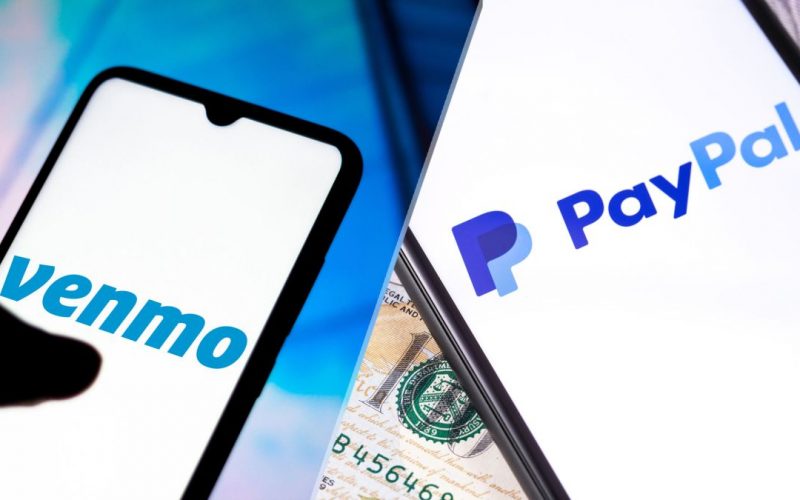There are tons of digital solutions available when you need to carry out any business transactions. And over the years, PayPal and Venmo have grown to the point that they are now used as verbs ( like “PayPal me” or “Venmo me”). But then how choosing wisely between the two depends mainly on the types of transactions you want to do and the individuals with whom you want to transact monies. Personal transactions with friends and family, like paying your babysitter or splitting a dinner bill, are particularly well-suited to Venmo, where you can also make your payments more social.
On the other hand, PayPal is the preferred method for more business-oriented transactions, such as purchasing from merchants or receiving payments from your own customers. In terms of business payments, Venmo is more of a peer-to-peer (P2P) network, whereas PayPal is more of a business-to-consumer (B2C) platform (B2C).
However, there are some overlaps between the two payment services. We went into the details on features, pricing, speed, and versatility to help you pick between them, providing you with all the information you need to make an informed decision.
Venmo vs Paypal: Overview
What is Venmo?
Venmo is part of PayPal’s bigger family of brands and is owned by PayPal. You can send and receive money instantly with this mobile payment app. The company touts its service as “secure, straightforward, and sociable” when it comes to sending money. Venmo can also be used to make purchases in person, online, or through the Venmo mobile app. It currently has a user base of 65 million people.
Who is it most suitable for?
Venmo is a consumer-friendly app with a social focus. It is intended up to be a quick and no-fee method of executing these transactions; that’s whether you need to pay a friend’s restaurant bill or divide the rent payment with your roommate. Venmo is also used by certain small businesses to accept payments.
How Does It Work?
Venmo allows you to link your bank account, debit card, or credit card to the app. This gives you the luxury of making any kind of payment; ranging from sending money, to transferring money back to your external accounts. You can keep money in Venmo as part of your Venmo balance.
You can also sign up for a direct deposit, which will put your paycheck into your Venmo account up to two days before your regular payday. Venmo’s partner banks, Wells Fargo Bank and The Bancorp Bank, offer pass-through FDIC insurance for your Venmo balance; but only if you’ve purchased bitcoin or deposited money to your Venmo account via direct deposit or remote check capture.
However, for person-to-person payments, merchant payments, and debit card purchases, Venmo imposes weekly transaction restrictions. The weekly maximum for person-to-person payments is $4,999.99. For authorized merchant payments Venmo Mastercard debit card purchases, it’s $6,999.99. In other words, each week, the total combined spending limit is $6,999.99. Let’s imagine you spent $3,800 on person-to-person payments over the course of a week. In the rolling weekly period, you’ll have $3,199.99 to spend on authorized merchant purchases and Venmo Mastercard debit transactions.
Pros
- It’s easy to transfer and receive money, as well as shop online.
- Unless you make certain types of transactions or receive money as a small business owner, there are rarely fees.
- To make payments easy and entertaining, it includes interactive social features and colorful emoticons.
- Debit and credit cards are available.
Cons
- Only available in the United States.
- For P2P transactions, merchant payments, and Venmo Mastercard debit purchases, the total weekly spending limit is $6,999.99.
- Other modes of payment, such as debit cards, credit cards, or cash, are more generally accepted at companies.
- Charges a fee of 1.5 percent for instant money transfers to an external bank account or debit card.
- Transactions may be publicly viewable to app users, making privacy settings difficult to navigate.
What is PayPal?
PayPal was one of the first digital payment companies, having been founded in 1998. It began as a way for users to transfer money via email or to pay for eBay purchases. With a 392 million client base and merchant accounts, PayPal now connects merchants and customers in over 200 countries.
PayPal (NASDAQ: PYPL) is a publicly-traded firm that owns multiple additional online retail and payment brands, including Venmo, Honey, Xoom, and Zettle. This online and mobile payment service features a mobile app for iOS and Android that allows you to make payments, send money to friends and family, request money, and more.
Who Is It Most Suitable For?
PayPal has similar functionalities as Venmo for sending money to friends and family and buying online. But then it has a more comprehensive selection of payment alternatives for small companies. PayPal may be a better option than Venmo if you need to receive payments from customers in person or online.
How Does It Work?
PayPal allows you to send and receive money in a variety of ways:
- Purchase On The Internet— You can use your PayPal account to make online purchases without inputting any personal financial information.
- Pay In Person— You can pay straight from your PayPal account. For example you can scann a QR code, if you’re shopping at a business that accepts PayPal payments.
- Send money to Over 200 Countries— If you have a friend or family member in another country, you can use PayPal to safely send money to them.
- You can receive money by using your own PayPal.me link or QR code. Alternatively, a Money Pool can be used to gather money from a group of friends.
- PayPal, like Venmo, lets you link your external bank account, debit card, or credit card to your PayPal account and use it as a source of funds.
- There are no restrictions to the amount you can send from your PayPal account in a particular time frame; that’s if you have a verified account. Basically, you can send up to $60,000 in a single transaction, although it may be limited to $10,000.
Pros
- Thousands of merchants accept it.
- PayPal is a global money transfer service that is available in over 200 countries and 25 currencies.
- It covers Robust business technologies that provide dependable payment methods and make consumer payments more convenient.
Cons
- PayPal’s charge structure is more complicated than Venmo’s.
- PayPal charges a 1% fee for quick money transfers to your external bank account or debit card.
- Its user experience is more complicated Venmo’s.
Venmo vs Paypal: Are They The Same Thing?
Despite the fact that PayPal owns Venmo, the two payment platforms are separate and have different purposes. A primary distinction is in transacting money with a friend or stranger. Venmo is a service that allows friends to transfer and receive money. PayPal has a broader reach, allowing you to accept payments from consumers, pay for goods and services, and send and receive money among friends and family members.
Can I Use PayPal To Pay on Venmo?
You can’t send money from PayPal to Venmo. Instead, you’ll have to be resourceful and transfer PayPal dollars to a Venmo-linked bank account, then withdraw the monies from Venmo.
Can I Send Money From Venmo to a PayPal Account?
Similarly, you can’t send money straight from Venmo to a PayPal account, but you may use Venmo to make payments at PayPal-accepting retailers. Tap the PayPal button on your mobile browser. If the merchant has enabled the feature, it will take you to checkout using your Venmo account.
Venmo vs PayPal
Venmo vs. PayPal: Sending Money and Making Payments
You can send money to friends and family or make purchases online and in shops using your Venmo or PayPal account balance. You can also do same for money in your linked bank account, debit card, or credit card. Here’s how to do it.
Family and Friends
Venmo allows you to integrate your contacts from your Facebook account or phonebook to make sending money easier. You can also scan the QR code of the person you wish to pay if you’re with them.
Basically, when you set up a PayPal account, the app imports contacts from your email accounts.
`So, if you want to transfer money to someone who isn’t on your contact list, you can look them up on PayPal or Venmo by name, username, email address, or mobile number. When you’ve found the right person, fill out the payment information, and the funds will be sent to their Venmo or PayPal account.
In-app and Mobile Purchases
As retailers, you can utilize Venmo and PayPal to make in-app and mobile transactions. Simply link your accounts and choose Venmo or PayPal as your payment method at checkout.
Online and In Stores
Venmo can be used to make purchases on mobile devices or through mobile web browsers, but not on a desktop computer.
It can also be used to make purchases both online and in stores. Venmo allows you to make contactless payments by scanning the business’s QR code and entering the payment amount at some brick-and-mortar locations.
You may also be able to pay using Venmo at some sites that accept PayPal. To see if Venmo is also accepted, go to the PayPal checkout page.
On the other hand, PayPal is frequently used both online and offline. Choose PayPal as your payment method at checkout (if it’s an option). You may use PayPal’s OneTouch function to stay logged in across all of your devices. This eliminates the need to re-enter your account credentials every time you wish to make a transaction. All it entails is scanning the merchant’s QR code, entering the payment amount, then hitting “send” each time you decide to use PayPal for in-person purchases.
Venmo vs PayPal: Receiving Money
While Venmo and PayPal are great for transacting money, they may also be used to collect payments from friends and family for small purchases. Here’s how to get paid quickly and effortlessly using either app.
Family and friends
Receiving money is simple and quick, regardless of the app you use. If you have a Venmo account, you can use the app to send payment requests to friends and family. When the funds are transferred to your account, you’ll be notified that the payment has arrived, and it will appear in green in your transaction history.
Read Also: ANNUITY VS 401k: Comparing the Risk and Benefits
Payment requests can also be sent using the app by PayPal customers. Create and share a clickable PayPal.me link or your QR code with friends and family to make it even easier. You’ll get a notification when the money is sent, letting you know it’s accessible. If you don’t already have a PayPal account, you’ll need to create one and validate your email address before accepting the payment.
Furthermore, you can add numerous recipients to a payment request in both apps if you require money from more than one individual.
Business
You’ll need a business account with both PayPal and Venmo to take payments for your company. Clients can pay you with Venmo via the mobile app or in-person using your business’s QR code once you’ve completed the Venmo sign-up process.
On the other hand, customers can pay with PayPal on your website, on their phone, through the app, or in person by scanning your QR code. You can also email them a link that they can click on. PayPal also has features that Venmo doesn’t, such as configurable invoice templates, seller protection, marketing assistance, and company finance alternatives.
Venmo vs PayPal: Fees
If you send money to anyone in the United States using money from your Venmo or PayPal account or a linked bank account, neither app will charge you a fee. However, if you use a credit card or begin receiving payments as a business, you may be liable to additional fees.
Fees by Credit Card
Venmo charges a 3% fee if you transfer money with a linked credit card. When you send money using a credit or debit card in the United States, PayPal charges 2.9 percent plus 30 cents.
Furthermore, PayPal charges a 5% fee for foreign transactions made with your PayPal balance, money from a linked bank account, or an Amex Send account (Amex Send is a peer-to-peer payment option offered by American Express in its app). If you pay with a credit or debit card, you’ll be charged 7.9% plus a fixed sum that varies depending on where you live.
Fees By Merchants
If you have a Venmo business account, each transaction will cost you 1.9 percent of the payment amount plus 10 cents. For business transactions, PayPal charges a merchant fee. Fees for transactions in the United States range from 2% to 3% plus a fixed fee of 30 cents, while fees for transactions outside the United States range from 3% to 4.5 percent plus a fixed fee (the fixed fee amounts depend on the country).
Fees for Bank Transfers
If you have money in your Venmo or PayPal account, you can transfer it for free to your linked bank account. The transfer, however, may take one to three business days to complete.
Both apps offer rapid transfers if you need to move money quickly. A quick transfer fee of 1%, up to a maximum of $10, is charged by both Venmo and PayPal. The minimum cost for Venmo is 25 cents.
PayPal vs. Venmo: Transaction limits and timing
The transaction limits of PayPal are higher than those of Venmo. Venmo limits all transfers to $299 per week if you haven’t completed your identity verification. There is a weekly spending limit of $6,999.99 across all transaction types once your identification has been validated.
Venmo also has a $4,999.99 weekly maximum spending limit for P2P payments and a $6,999.99 weekly maximum spending limit for authorized merchant payments. A $4,999.99 per-transaction limit for P2P payments and $2,999.99 for merchant payments is also in place.
There is no restriction to how much money you can send from your PayPal account after verification. However, there is a limit to how much you can send in a single transaction; $60,000 in most cases. But then PayPal may only accept up to $10,000 in exceptional circumstances.
When you use money from your Venmo or PayPal account or a linked credit or debit card to cover a transaction, it just takes a few minutes to complete.
Accessibility for Venmo vs PayPal
PayPal and Venmo each have their own free iOS and Android applications. This is where the majority of users will go to use their services. They also have desktop browser versions as well. Venmo payments, on the other hand, can only be done via the mobile app.
PayPal can be used to pay for goods and services from a wide range of online retailers, as well as for in-store QR code purchases. Venmo is striving to expand its merchant transaction capabilities among additional businesses, although its reach is currently limited in comparison to PayPal’s vast network.
Additional Features of Venmo vs PayPal
As you can see, the two services have a lot in common in terms of basic features and pricing. However, there are a few instances where the two apps are significantly different. Venmo, for example, displays a social feed of transactions that have taken place among people you know, as well as strangers; that’s if you choose to browse the public feed, due to its heavy concentration on transactions between people who know each other personally.
A quick look through your Venmo pals’ transaction stream will reveal who paid who and with what message they shared. The quantity is the only thing that is lacking. Emojis, which are almost as ubiquitous as text in the Venmo social feed, are also supported. When you create your own transactions in the app, the default setting is to share them with everyone, but you may alter it to only your Venmo pals or only the recipient, either worldwide or transaction by transaction.
Read Also: Venmo Account Frozen: Why is Venmo Freezing? (Best Stressfree Solutions)
PayPal has an advantage over Venmo in that it can be used by both merchant sellers who accept payments and customers and buyers at both online and physical businesses. PayPal, which began as eBay’s payment processor, excels in facilitating transactions between strangers, including providing protections for both sellers and purchasers that Venmo does not.
Furthermore, PayPal also accepts international payments. It is the app of choice for those who want to send or accept funds from people outside the United States, as it covers more than 200 countries and transacts in around 25 different currencies. Venmo, on the other hand, can only be used in the United States.
Finally, both Venmo and PayPal have their own credit and debit cards, but Venmo’s is very new. Payments to anyone who accepts that card type can be debited immediately to your PayPal or Venmo account when you get a debit or credit card.
Venmo vs PayPal: Business Features
PayPal’s image as the digital payments app of choice for retailers is further cemented by the fact that it offers a slew of small business features that Venmo’s more person-to-person focused business model completely lacks.
Merchants that open a PayPal Business account, for example, can utilize the service to set up the financial transaction side of selling things online. This makes it simpler to take credit and debit card payments from all around the world. Merchants agree to a tiny percentage fee being deducted from each transaction in exchange for this feature.
However, PayPal’s assistance to small businesses extends far beyond payment processing. Invoicing, product shipping, and marketing data are all available with PayPal Business. Some services are standard with the basic business package, while others require a PayPal Payments Pro account, which has a monthly maintenance fee.
Also, PayPal offers working capital and company loans up to $500,000, some of which can be obtained without a credit check, to growing enterprises aiming to scale.
Venmo vs PayPal Review
The Venmo and PayPal applications have similar ratings on the Apple App Store and Google Play Store; 4.9 stars on iOS with roughly 11 million reviews and 4.4 stars from about 443,000 Android users. The ease of use is a major factor in the positive reviews, with both applications being well-designed and allowing payments and requests to be made with only a few simple taps.
Alternatives to Venmo vs PayPal to Consider
PayPal and Venmo are two apps that allow you to transfer and receive money online using your phone. Gone are the days of running to an ATM to withdraw cash in the hopes of getting the precise amount or having an exact change from your buddies. However, there are several variations between the apps; Venmo is designed for rapid peer-to-peer transfers in the United States, whereas PayPal is designed for businesses and worldwide transactions.
If you’re not sure if either app is perfect for you, here are some other options to think about.
Zelle: If you’re searching for an app to help you divide the dinner bill or pay your rent, Zelle might be a smart choice. It’s designed to let users send and receive payments from people they know, similar to Venmo. The money isn’t held in a Zelle account like it is with Venmo. Instead of transferring money back and forth, it goes between the sender’s and receiver’s bank accounts.
Automatic Bill Pay: If you want to make paying your bills a little easier each month, consider setting up recurring payments through a linked bank account.
Mobile Wallets: If you need a secure way to pay at your favorite online or brick-and-mortar retailers, or if you want a simple way to take payments for your business, mobile wallets like Google Pay (for Android phones) or Apple Pay (for Apple devices) may be worth a try. Google Pay and Apple Pay, unlike PayPal, do not levy separate merchant fees.
Why You Shouldn’t Use Venmo?
Venmo was created as a peer-to-peer payment app, which means that it may be used to send money between friends and relatives. Its personal accounts aren’t intended to be used by small enterprises as an online payment option. That implies you won’t be able to file your taxes because you won’t have any records.
Which One Is Better PayPal or Venmo?
PayPal has similar features to Venmo for sending money to friends and family and ordering stuff online, but it has a more comprehensive selection of payment alternatives for small businesses. PayPal may be a better option than Venmo if you need to receive payments from customers in person or online.
Is Venmo a Good Alternative to PayPay?
Venmo is one of the better peer-to-peer payment options. Venmo isn’t a good choice if you’re searching for a PayPal credit card processing alternative for your business, but it’s a good option if you need to send money fast to someone else.
What Are the Disadvantages of Venmo?
- Some services have fees.
- If you don’t change the privacy settings, your privacy could be at risk.
- You can’t get money right away unless you pay a fee.
- There’s no way to earn interest on money you put in Venmo.
Do You Need a Bank Account For Venmo?
You need to link the Venmo app to a U.S. bank account, debit card, prepaid debit card, or credit card in order to send money. If you get money through Venmo and want to move it to your bank account, you will need to link a bank account. Don’t link a savings account, but a checking account.
Related Articles
- How To Add Money To Venmo: Best Easy Guide (Updated)
- How Does Paypal Work? Pros, Cons & All You Need!!!
- Venmo Account Frozen: Why is Venmo Freezing? (Best Stressfree Solutions)
- Paypal Transaction Fees: What are The Transaction and How to Avoid The Unnecessary Fees
- The Bad Side Of PayPal You Probably Are Oblivious To






